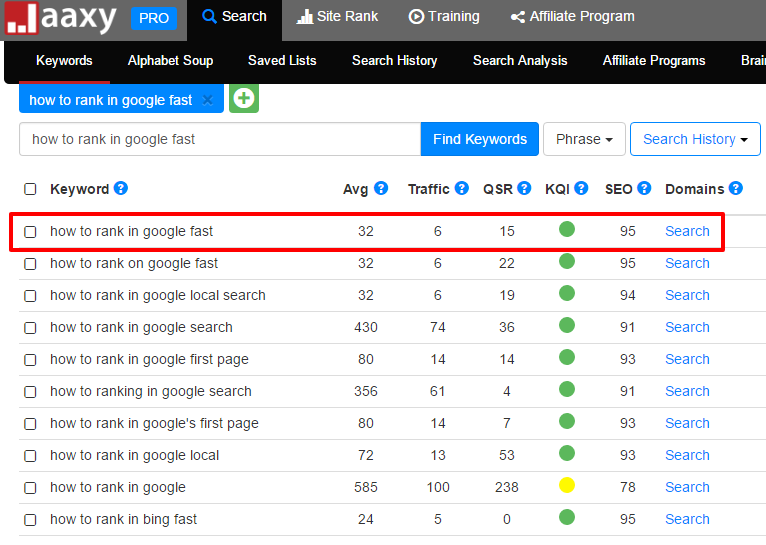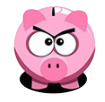This is quite a tricky topic for many people and a lot of people struggle to get ranking in Google. I would like to help you along the path to actively finding yourself ranked on the first page of Google, with multiple keywords.
Hopefully, after you have read this article, you will be able to create some better content to help you achieve higher rankings.
What will be covered?
- how to find keywords
- content development
Chase The Low Hanging Fruit
The best approach – especially when you are just starting out – is to focus on the low competition and low traffic volume keywords. Also, known as “low hanging fruit”.
Why? This is because these keywords which have very low traffic volume are easier to rank, which leads to a small but achievable traffic stream. This, in turn, means your website gets increased engagements, comments and ultimately more authority in the eyes of the search engines.
As you gain more authority you can try and target more competitive – and higher volume – keywords which other well-established websites will also be targeting.
How To Find The Low Hanging Keywords
Once you have an idea for an article, the first step is to use the alphabet soup technique to explore your keyword phrase. This is a very simple technique where you type your initial keyword ideas into Google and let the auto-fill function give you a tonne of new ideas to explore. So, for example, if you type in “How to rank in Google f”

As soon as you type in the additional “F”, you get three more keyword ideas. Then you can try any other letter and, even more, ideas will pop up. You can even try a whole new keyword and Google will do all the work for you – giving you hundreds of new keyword ideas from one simple idea. Here are a few other example using the letters “p” and “m.”


Once you have got an excellent list of potential keywords, you want to research to see how many searches/traffic and competition there is you want to head over to Jaaxy and begin your keyword research. Here you will analyse and narrow down which keyword phrase has the lowest hanging fruit.
If you have no idea what Jaaxy Keyword Research Tool is then have a look and watch the tutorial videos. It’s FREE to join. It’s a search tool which tells you how many people search for a certain keyword phrase and how much traffic and competition there is for that particular keyword. It is essential to rank well within Google. But, I digress…
Once you have found some keywords which have low competition and has a small amount of traffic. You have a winner! As you can see in the image below the keyword which Google auto fill helped us find – using the alphabet soup technique – is an excellent example.
With 32 searches per month and a very low competition score, we have an excellent chance of ranking on 1st page of Google if we targeted this phrase.

I know what you are thinking…
“32 searches!?? That’s nothing! I need more traffic than that!”
Well, you don’t. Think about it. If you wrote ten articles each targeting low competition keywords which you can very realistically rank for then you have a target audience of hundreds. In a few months, it will be thousands as you write more content. Once your website gains engagement with visitors, the site authority will grow and THEN you can target more competitive words.
The idea is to find the keywords which are easy pickings – still running with the fruit metaphor, I know – because from there you can build.
Rinse and repeat. Now once you have found a keyword phrase which is a good match you go back with more ideas to Google and let the auto-fill/alphabet soup technique do the work for you. Each keyword phrase is another article topic which you can build around.
Content Development
Title – you want your keyword phrase as your title. However, you want to make it a bit more captivating and natural. So you don’t want to have simply your title as “How To Rank In Google Fast”. That is too bland. You want to make it seem natural so perhaps “How To Rank In Google Fast – For Beginners” or “..On A Budget”. These make the title more informative and give structure to your upcoming article.
Content – ideally you want to keep your paragraphs as bite size chunks. Remember people have a VERY short attention span online so you HAVE to make your paragraphs short and to the point. Separate your content out neatly and add pictures to break up the content. Make it readable. Use bullet points, headers and break lines to create a clean and crisp article which is easy to read.
Engage – don’t be boring! Be factual if you need to and be thorough but try and engage the audience. Ask them to leave comments. Leave them with questions on the topic to make them participate. Try to image that you are reading the article and make it interesting and engaging.
Keyword Placements – have your keyword in the title and perhaps in the first paragraph, then write naturally. The last thing you want to do it to stuff your article full of phrases and words you think Google wants to see. Write naturally. Google will take care of the rest.
If you can get to grips with what the low competition keywords look like, then you have access to unlimited amounts of traffic. From there you can grow and develop your website with ad placements, videos, newsletters and much much more but it all starts with the low-hanging fruit and your very first Google page one ranking.

Hi Phillip,
I really like this theory of low hanging fruit. I was wondering if you have had any success with this technique?
I am doing a case study at the moment for this article. I am using the example I found right here in this article to see if I can rank on the first page by using this technique. Case Study.
Hi Philip,
Great article regarding this low hanging fruit technique.
I’m always struggling with where to find inspiration for writing ideas. What a great idea.
This company Wealthy Affiliate, do they teach these techniques and this keyword tool?
I’ll be joining as a member if their training is as detailed as this.
Thanks for your time,
Simon.
Hi Simon, thank you for taking the time to leave a comment!
Yep, they do teach the low hanging fruit technique + everything you need to know about targeting keywords. I highly recommend joining if you get a chance. After all, it is free to create an account and start your first website. 🙂
Philip